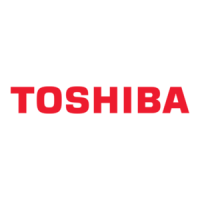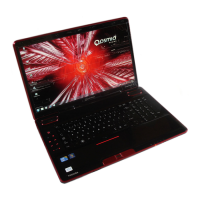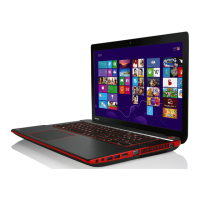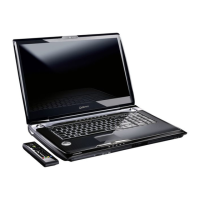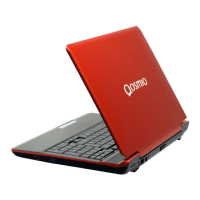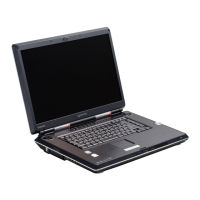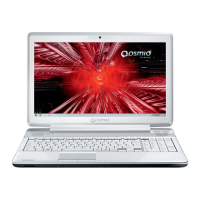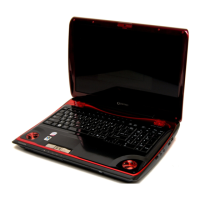
Do you have a question about the Toshiba Qosmio X300 Series and is the answer not in the manual?
| Processor | Intel Core 2 Duo |
|---|---|
| Chipset | Intel PM45 Express |
| RAM | Up to 4GB DDR3 |
| Display | 17-inch |
| Optical Drive | Blu-ray Disc drive or DVD SuperMulti drive |
| Operating System | Windows Vista |
| Wireless | Wi-Fi 802.11a/g/n |
| Audio | Harman Kardon stereo speakers |
| Ports | USB 2.0, HDMI, eSATA, ExpressCard, VGA, Ethernet, headphone/microphone jacks |
| Connectivity | Ethernet, Wi-Fi, Bluetooth |
Lists items to check when unpacking the computer to ensure all parts are present.
Details the physical components and hardware included with the computer.
Lists the various documentation provided with the computer.
Lists the pre-installed Windows operating system and utility software.
Describes the built-in Intel processors, including cache and SpeedStep technology.
Details memory slot specifications and maximum system memory capacity.
Describes the types of hard disk drives (HDD) and solid-state drives (SSD) available and their capacities.
Details the DVD Super Multi drive's read/write speeds and supported media formats.
Lists the available 17" TFT LCD screen resolutions with millions of colors.
Describes the built-in keyboard features, including numeric overlay and cursor keys.
Explains the integrated Touch Pad for controlling the pointer and supporting functions like scrolling.
Describes the 15-pin analog VGA port for connecting an external monitor.
Describes the Universal ExpressCard slot supporting ExpressCard/54 and /34 modules.
Details support for internal speakers, microphone, and external audio devices.
Explains connecting to a TV via HDMI for video, audio, and control signals.
Explains the computer's wireless communication functions supporting Wireless LAN and Bluetooth.
Recommends enabling encryption for wireless connections to prevent illegal access and data loss.
Highlights unique or advanced features that enhance computer usability.
Illustrates and describes the computer's front view when the display is closed.
Details the components and ports located on the left side of the computer.
Identifies and describes the ports and features on the right side of the computer.
Shows the rear view of the computer and labels its various ports and connectors.
Illustrates the bottom of the computer, showing cooling vents, memory slots, and battery release.
Shows the computer with the display open, labeling key components like the webcam and touchpad.
Explains the meaning of various LED indicators on the computer for status and operations.
Describes the CAPS LOCK and NUM LOCK indicators and their functions.
Details the DVD Super-Multi drive, its capabilities, and region codes.
Explains the function, specifications, and usage of the AC power adapter.
Provides detailed instructions on attaching the AC adapter for charging or operating from AC power.
Guides users on how to open the computer's display panel to a comfortable viewing angle.
Explains how to turn on the computer's power and the status indicated by the Power indicator.
Describes the three modes for turning off the computer: Shut Down, Hibernation, and Sleep.
Allows turning off power without exiting software, maintaining data in memory.
Saves memory contents to hard disk, restoring the previous state upon next startup.
Provides three methods for restarting the computer when certain conditions require it.
Describes the hidden partition for recovery options and tools to repair startup problems.
Guides users on creating Recovery Discs using DVD media.
Explains how to restore pre-installed software from a hidden recovery partition.
Explains how to use the touchpad for controlling the on-screen pointer and its functions.
Describes the front operation panel for AV functions like Play/Pause and Mute.
Details the fingerprint utility for enrolling and recognizing fingerprints for authentication.
Provides steps for swiping fingers on the sensor to minimize authentication failures.
Explains using fingerprint authentication instead of the usual Windows logon process.
Describes the Web Camera for recording video and taking photos, used for video chatting.
Uses face verification for logging into Windows automatically.
Guides users on taking pictures and registering data for facial verification when logging in.
Describes the drive's high-performance execution of CD/DVD-ROM based programs.
Provides steps for loading CD/DVDs into the computer's disc tray.
Provides steps for removing CD/DVDs from the computer's disc tray.
Explains using the DVD-R drive for writing data and the provided software.
Discusses limitations when using TOSHIBA Disc Creator for various media and functions.
Describes how to connect and disconnect the internal modem to a telephone jack.
Explains the computer's wireless communication functions supporting Wireless LAN and Bluetooth.
Provides tips for keeping the computer clean and free of dust and dirt.
Explains the basic function of the typewriter keys and differences from a manual typewriter.
Describes the function keys and their programmed operations on the computer.
Details how the FN key combines with other keys to form soft keys for specific features.
Explains hot keys that enable or disable computer features quickly using key combinations.
Makes the FN key sticky using the TOSHIBA Accessibility Utility.
Describes the Windows Start Button key and the application key for mouse functions.
Describes the full-sized keyboard layout with a numeric keypad.
Explains how AC adapter connection and battery status affect computer capability and charge.
Explains the meaning of Battery, DC IN, and Power indicators for status and battery charge.
Describes the removable lithium-ion battery pack as the main power source.
Provides power for the RTC and maintains system configuration when the computer is off.
Provides instructions for safe handling and optimal performance of the battery pack.
Explains how the Battery indicator signals low power and the need to recharge.
Lists conditions that may delay battery charging and how to monitor capacity.
Explains factors affecting battery usefulness and how to optimize operating time.
Provides steps to maximize battery pack life, including regular discharge and proper storage.
Explains how to safely remove and install the battery pack, including safety precautions.
Provides two levels of password security: User and Supervisor.
Explains the three power-up modes: Shut Down, Hibernation, and Sleep.
Guides users on how to start the TOSHIBA HW Setup program.
Describes the HW Setup window's tabs (General, Password, etc.) and buttons (OK, Cancel, Apply).
Allows setting or resetting the user password for power on.
Allows selection of the display to be used when the computer is switched on.
Sets the priority for booting the computer from various devices like USB, Network, or CD/DVD.
Enables turning on the computer by pressing any key while in Sleep mode.
Allows charging USB devices via ports even when the computer is turned OFF.
Lets the computer power turn on when it receives a wakeup signal from the LAN.
Lists various memory cards and expansion options like ExpressCard and Bridge media slot.
Lists power-related optional devices such as battery packs and universal AC adaptors.
Lists external peripheral devices like USB floppy drives, monitors, and HDMI.
Describes the ExpressCard slot and its capabilities for installing ExpressCard devices.
Details the steps for safely removing an ExpressCard from the computer.
Describes the slot accommodating memory media for easy data transfer from devices.
Provides important safety precautions for handling SD/SDHC memory cards.
Offers precautions for handling memory cards, including insertion and storage.
Provides instructions for inserting memory media into the computer's bridge media slot.
Explains how to install additional memory to increase system memory and operate in dual channel mode.
Provides steps for installing memory modules, including safety precautions and screw removal.
Details the steps for removing memory modules, including safety precautions.
Information on increasing portability with additional battery packs.
Describes the USB floppy diskette drive and its connection to USB ports.
Describes connecting eSATA devices to the computer's USB (eSATA combo) port.
Explains connecting an external analog monitor to the computer's external monitor port.
Explains viewing video data on a TV set by connecting the HDMI out port to the TV.
Describes i.LINK (IEEE1394) for high-speed data transfer between compatible devices.
Allows anchoring the computer to a desk or object to prevent unauthorized removal or theft.
Offers guidelines for resolving problems by stopping immediately and observing system behavior.
Lists simple solutions to common problems, such as checking peripheral devices and cables.
Guides users on identifying problems by examining computer parts, system configuration, and indicators.
Lists common problem areas related to hardware, software, and attached peripherals.
Lists items to check when the computer does not start properly, such as Self Test and Power Sources.
Explains the automatic self-test performed during startup and conditions indicating failure.
Discusses computer power sources and potential power-related problems.
Explains automatic system shutdown into Hibernation or Sleep Mode due to high internal temperature.
Provides troubleshooting steps for AC power issues, focusing on the DC IN indicator.
Addresses battery-related problems, including power issues and charging failures.
Discusses display panel problems related to computer setup and configuration.
Suggests running disk defragmentation or reformatting the drive as a last resort.
Provides steps to ensure the disc tray is closed, media is seated, and the disc is clean.
Advises checking the connection between the computer and the drive.
Advises removing and reinserting the ExpressCard or checking external connections.
Suggests removing and reinserting the card or checking documentation for persistent issues.
Suggests removing and reinserting the Memory Stick or checking documentation.
Suggests removing and reinserting the xD picture card or checking documentation.
Suggests removing and reinserting the MultiMediaCard or checking documentation.
Suggests trying to move the mouse again after waiting if the system is busy.
Suggests trying to move the mouse again or reconnecting it to a USB port.
Suggests trying again with the correct finger position or another enrolled finger.
Advises removing and reconnecting the device, ensuring drivers are installed, or enabling emulation.
Addresses issues with the USB Sleep and Charge function not working or depleting the battery quickly.
Advises removing and reconnecting the eSATA device and ensuring drivers are installed.
Addresses issues with memory modules and the power indicator flashes.
Suggests checking volume controls, software settings, and mute status.
Addresses external monitor issues like not turning on or no display.
Provides troubleshooting for modem communication issues.
Checks for a firm cable connection between the LAN jack and HUB.
Ensures the computer's wireless communication switch is set to on.
Checks switch, manager application, and ensures no optional Bluetooth adaptor is installed.
Checks cable attachment, device power, reinstalling drivers, and restarting the computer.
Suggests BIOS configuration changes for smooth DVD playback.
Adjusts the FM tuner antenna and checks connection security.
Advises reviewing software/peripheral documentation and consulting TOSHIBA for technical assistance.
Explains CPU performance variations based on external peripherals, power modes, and environmental conditions.
Applies to Intel Core 2 Duo models, detailing hardware and software requirements for 64-bit computing.
Discusses how graphics systems use main memory, affecting availability for other tasks.
Explains battery life variations based on model, configuration, and usage, and the need for replacement after time.
Clarifies byte conversion for capacity display and factors affecting available storage.
Notes that LCD brightness deteriorates over time and is maximum only in AC power mode.
Discusses GPU performance variations based on model, configuration, and power mode.
Explains how wireless LAN transmission speed and range vary based on environment and configurations.
Recommends adjusting LCD brightness to prevent eye strain.
Provides safety instructions for operating the computer with a TV tuner during thunderstorms.
Refers to the User's Manual for information on the computer's weight and dimensions.
Details the operating and non-operating ambient temperature and altitude requirements.
Lists the voltage and frequency specifications for the AC adaptor.
Details the type of NCU and line used by the modem.
Details data and fax transmission speeds supported by the modem.
Explains how the display controller interprets commands for screen output and resolution.
Guides users on configuring video mode settings via Display Properties for optimal display.
Lists the form factor, compatibility, operating system, and protocol for the Wireless LAN card.
Details how country/region and product type affect Wireless LAN radio characteristics.
Explains that Wireless LAN card support for channels varies by region and regulations.
Discusses Bluetooth technology's radio frequency energy and safety guidelines.
Outlines compliance with general product specifications and EU/EFTA directives.
States compliance with Industry Canada RSS 210 regulations.
Details FCC compliance for Class B digital devices and measures to correct interference.
Provides cautions regarding radio frequency exposure and proper use of the Bluetooth™ Card.
Discusses frequency bandwidth and sticker placement for Bluetooth in Japan.
Lists certification agencies for AC power cords in various regions like US, Canada, Australia, Japan, and Europe.
Describes restrictions related to TV antenna signals, copyright protection, and peripheral compatibility.
Lists and defines abbreviations used throughout the manual.
Defines terms starting with 'A', such as adaptor, allocate, alphanumeric, alternating current, and analog signal.
Defines terms starting with 'B', such as backup, batch file, binary, BIOS, bit, board, boot, bps, and buffer.
Defines terms starting with 'C', such as cache memory, capacity, CD-ROM, CD-R, CD-RW, character, chassis, chip, CMOS, cold start, COM ports, commands, and communications.
Defines terms starting with 'D', such as default, delete, device driver, dialog box, Digital Audio, disk drive, disk storage, display, and documentation.
Defines DVD-R Double Layer discs and their capacity.
Defines terms starting with 'F', such as fast infrared, file, fingerprint sensor, firmware, floppy diskette, Fn-esse, folder, format, and function keys.
Defines terms starting with 'H', such as hard disk, hard disk drive, hardware, hertz, hexadecimal, host computer, hot key, and HW Setup.
Defines terms starting with 'I', such as icon, i.LINK, input, instruction, and interface.
Defines warm start, window, Wireless LAN, write protection.
